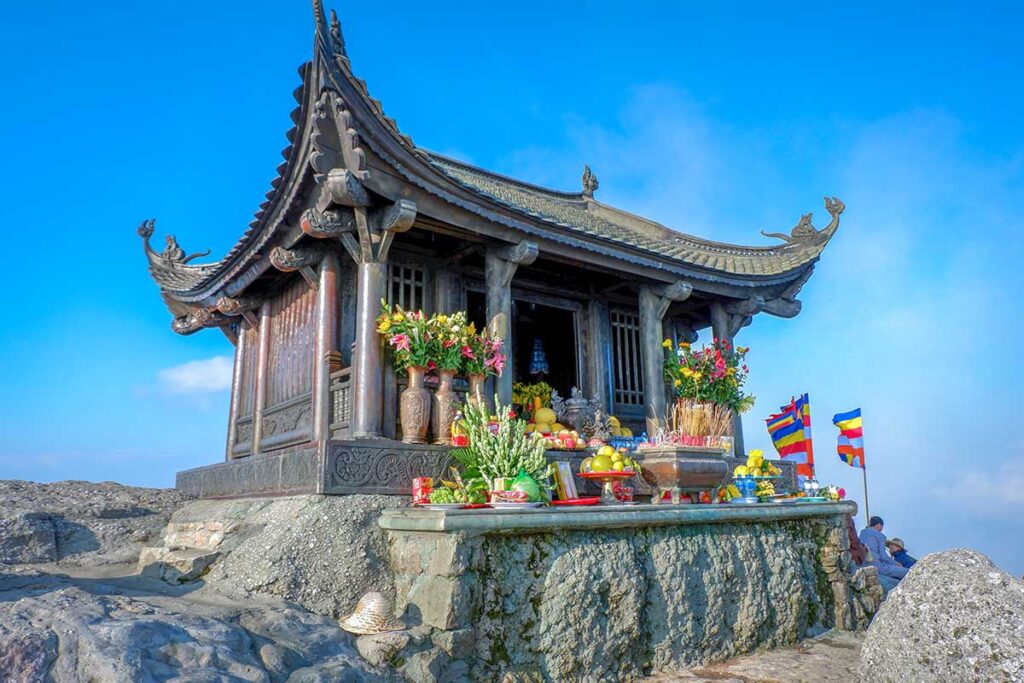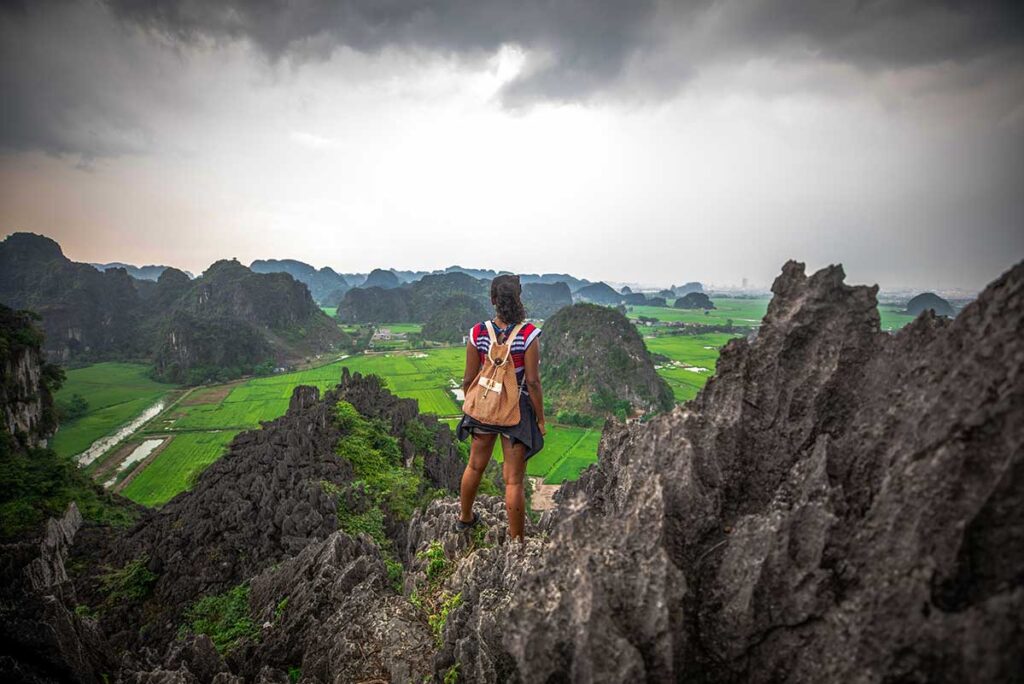What is Yen Tu?
Yen Tu is both a spiritual landmark and a scenic mountain retreat, attracting pilgrims, nature lovers, and history enthusiasts alike. Covered in ancient pine forests and misty peaks, the mountain is dotted with centuries-old pagodas, stone pathways, and forest shrines that form part of Vietnam’s Buddhist heartland. Recognized in 2025 as a UNESCO World Heritage site, Yen Tu is revered as the birthplace of Truc Lam Zen Buddhism, where King Tran Nhan Tong renounced the throne to pursue a monastic life.
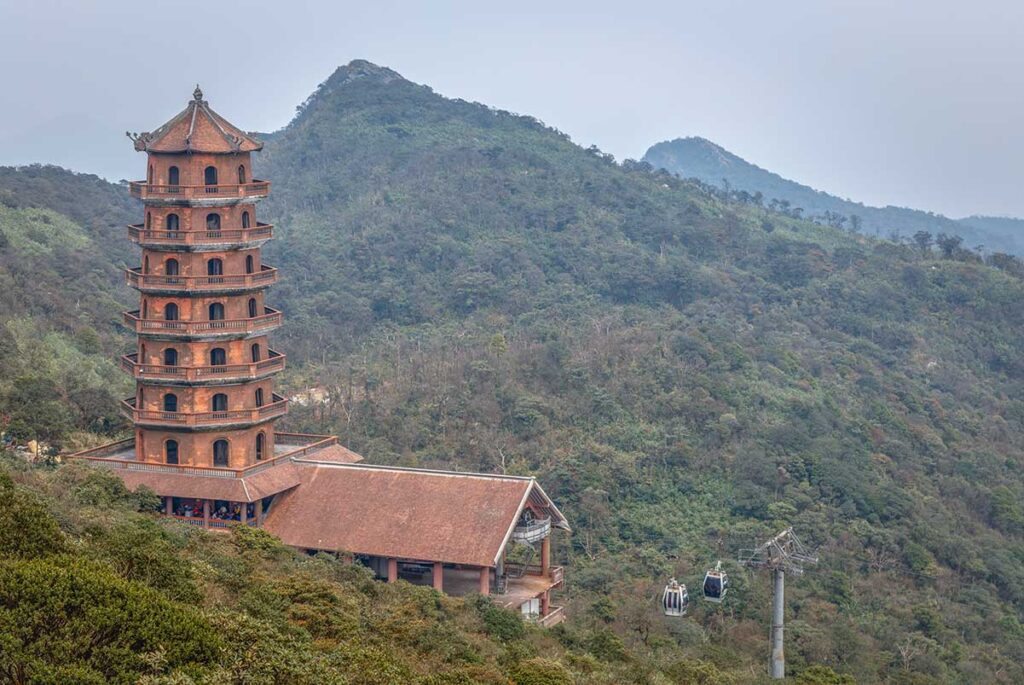
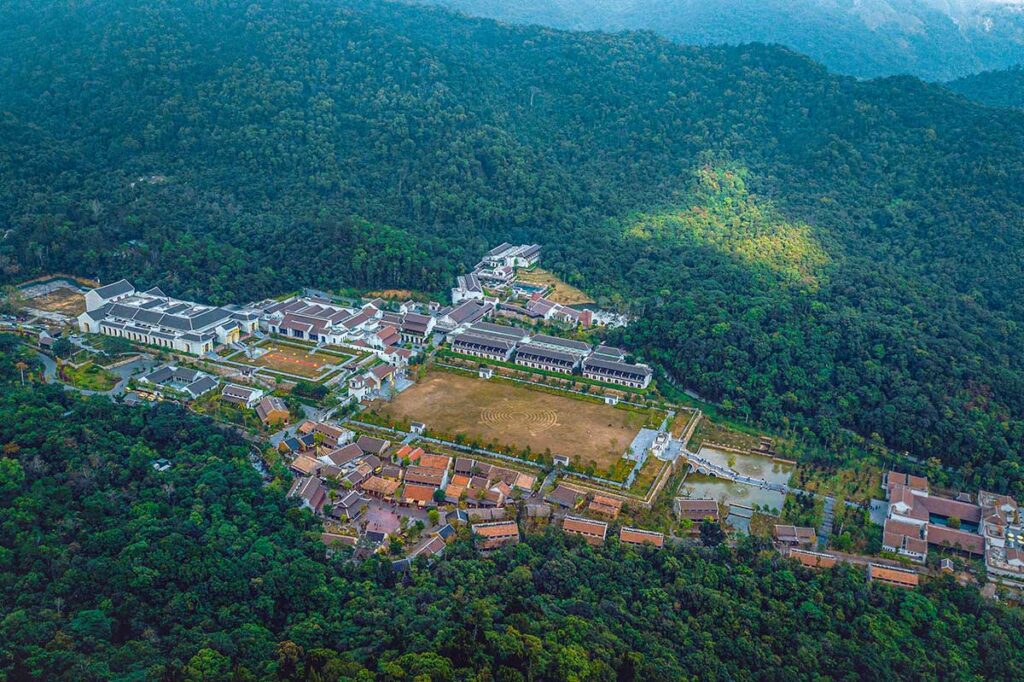
Yen Tu offers two different entry points, each with its own character:
- Tay Yen Tu (Bac Giang side): Newer tourist facilities, a modern cable car system, and less crowded trails.
- Yen Tu Pagoda (Quang Ninh side): More historical, with older pagodas, traditional hiking routes, and the iconic bronze Dong Pagoda at the summit.
The full pilgrimage route is both cultural and physical:
- Hike or take the cable car through lush mountain forests and temple complexes.
- Walk among towering trees, mossy stone steps, and cloud-covered viewpoints.
- Experience the spiritual energy of pagodas nestled along the route, often accompanied by the sound of bells or chanting.
Highlights & Pagodas to visit
Yen Tu Mountain is dotted with sacred temples, scenic viewpoints, and historic monuments, with access points from both Quang Ninh (east) and Bac Giang (west – Tay Yen Tu). You can visit each side on its own, or cross between them via a summit trail. Below are the most notable sites to explore, grouped by location
Yen Tu Pagoda Complex (Quang Ninh Side)
1. Dong Pagoda
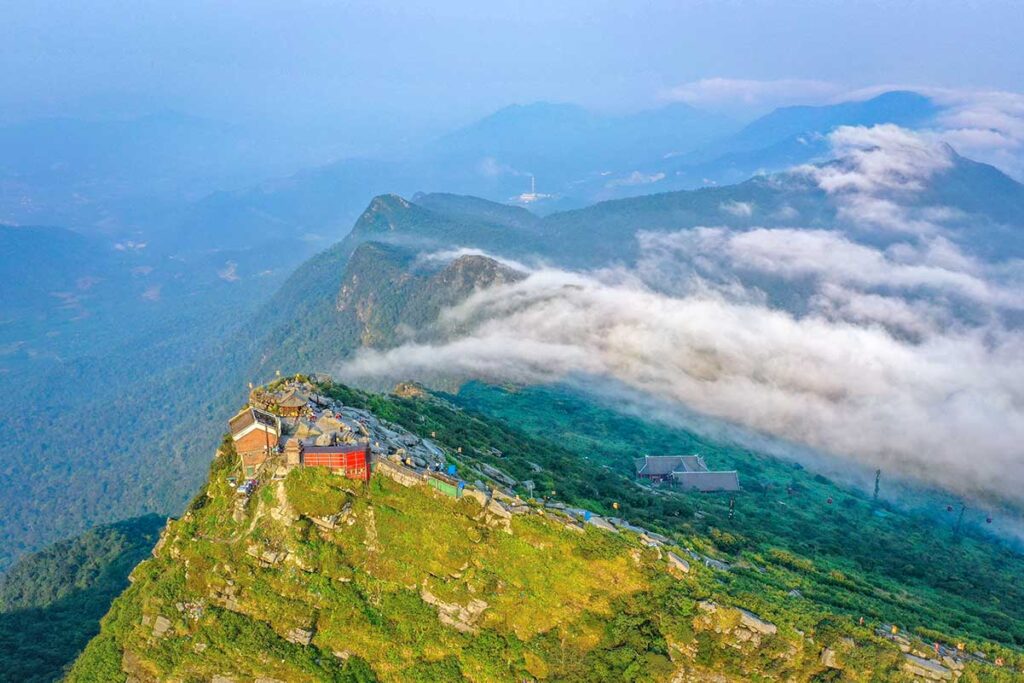
Located at the summit of Yen Tu Mountain at 1,068 meters above sea level, Dong Pagoda is the most iconic structure in the entire complex. Cast entirely in bronze and weighing around 70 tons, it stands as a symbol of Vietnamese Buddhist architecture.
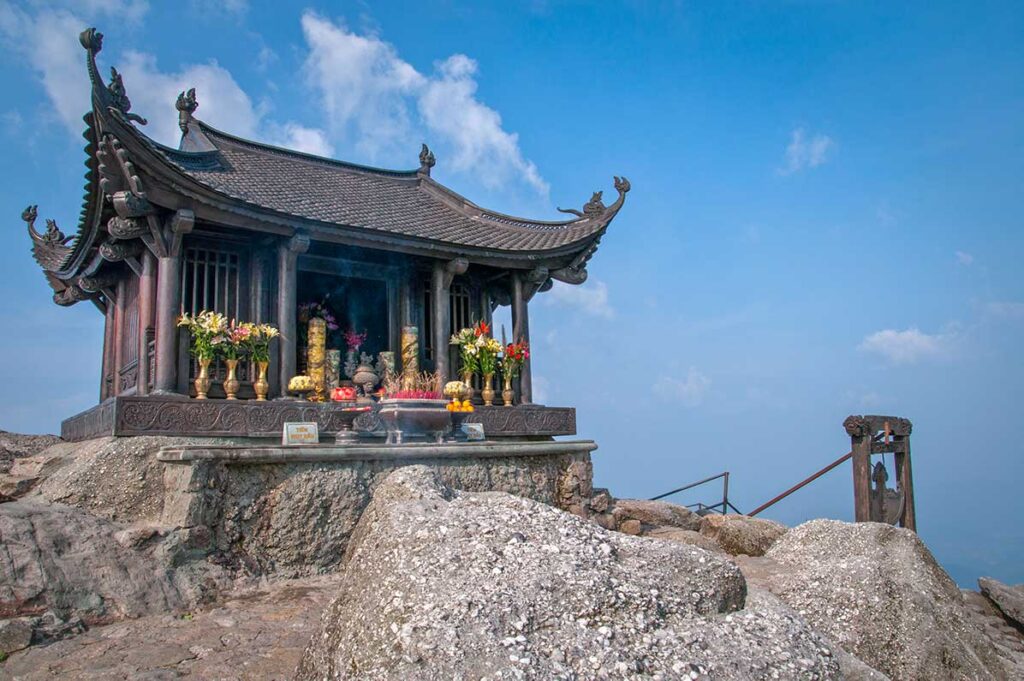
The small, square temple is known for its elegant dragon-shaped roof corners and its position above the clouds. Getting here requires either a combination of cable car and hiking or a full trek on foot, and the views from the top are among the best in the region.
2. Hoa Yen Pagoda
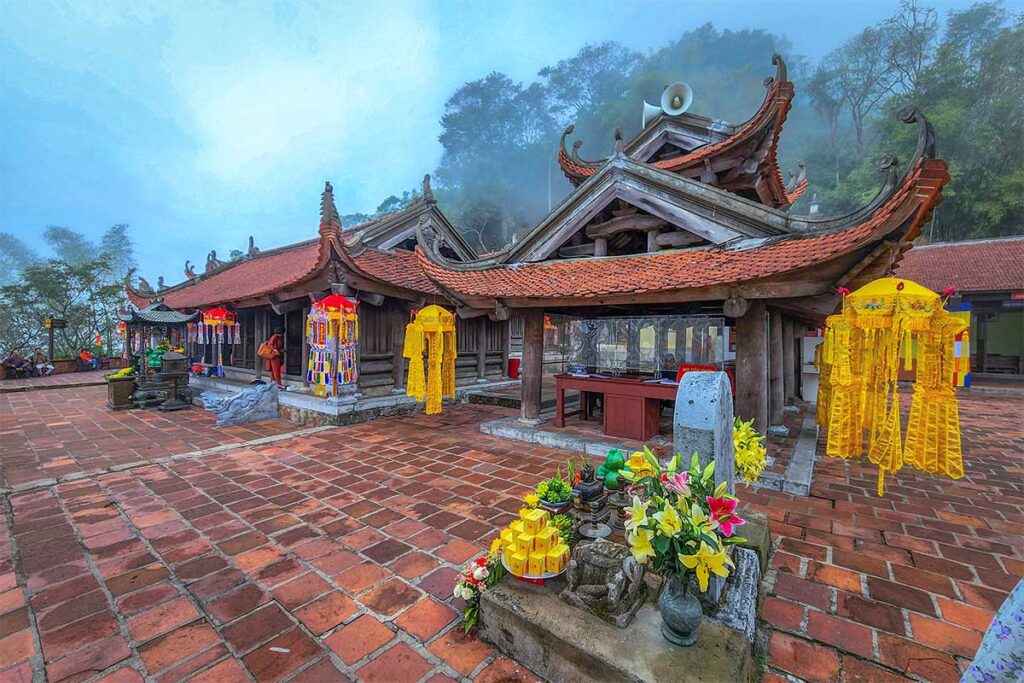
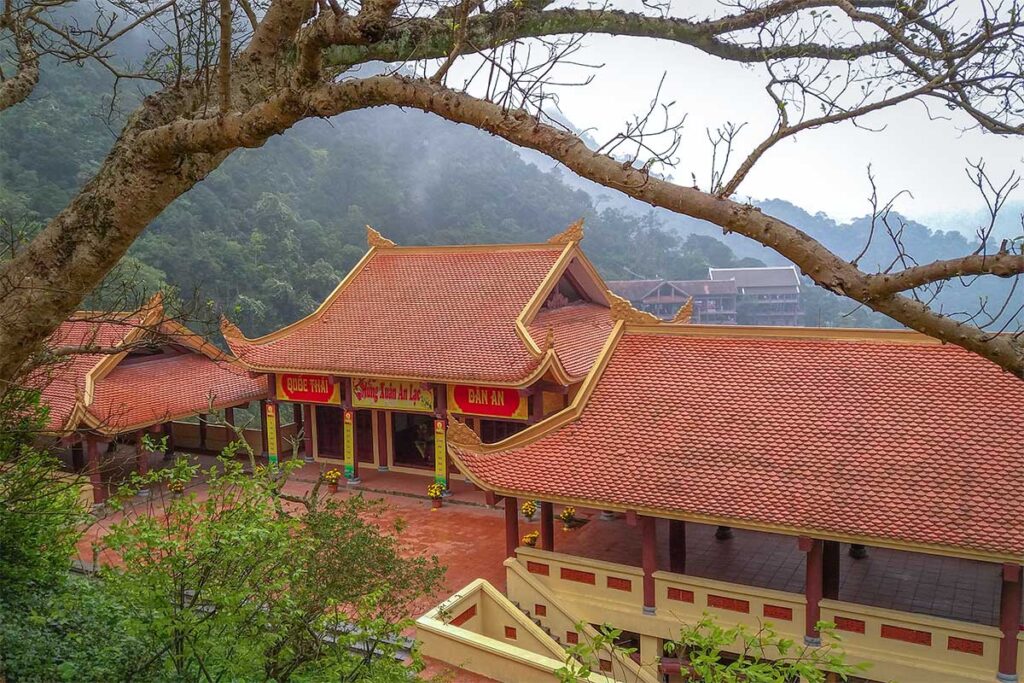
Hoa Yen is one of the main temples on the pilgrimage route and sits at 534 meters altitude, nestled on a flat area surrounded by ancient pine trees. Originally built in the Tran Dynasty, the pagoda has been restored multiple times, most recently in 2002.
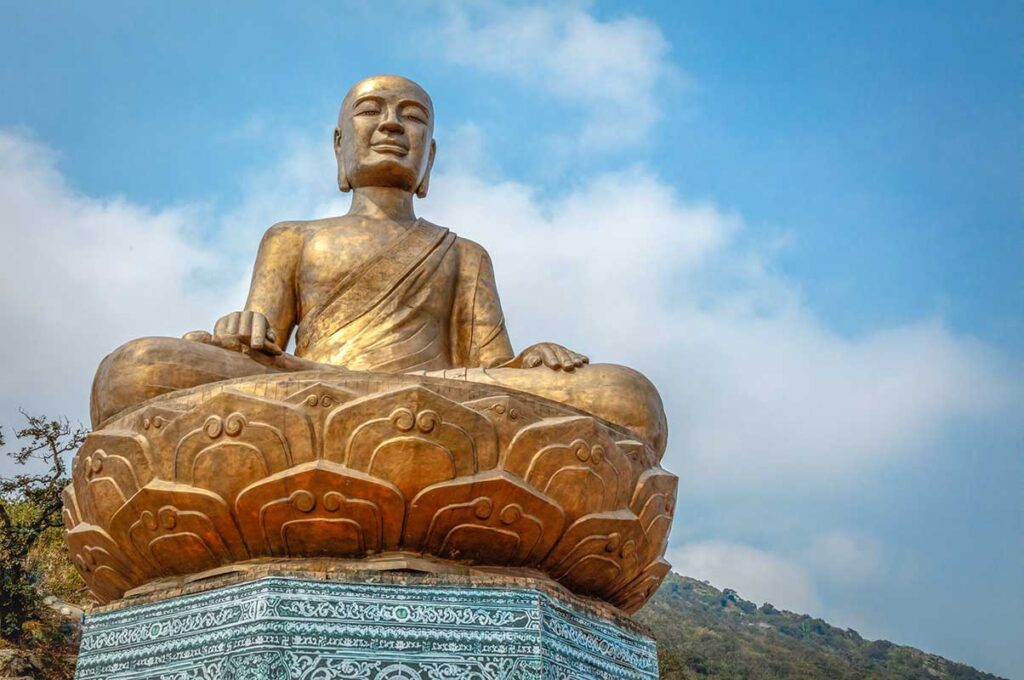
The site includes a main worship hall, ancestor shrine, and bell and gong towers. This is often the first major stop if climbing from the Quang Ninh side.
3. Giai Oan Pagoda & Stream
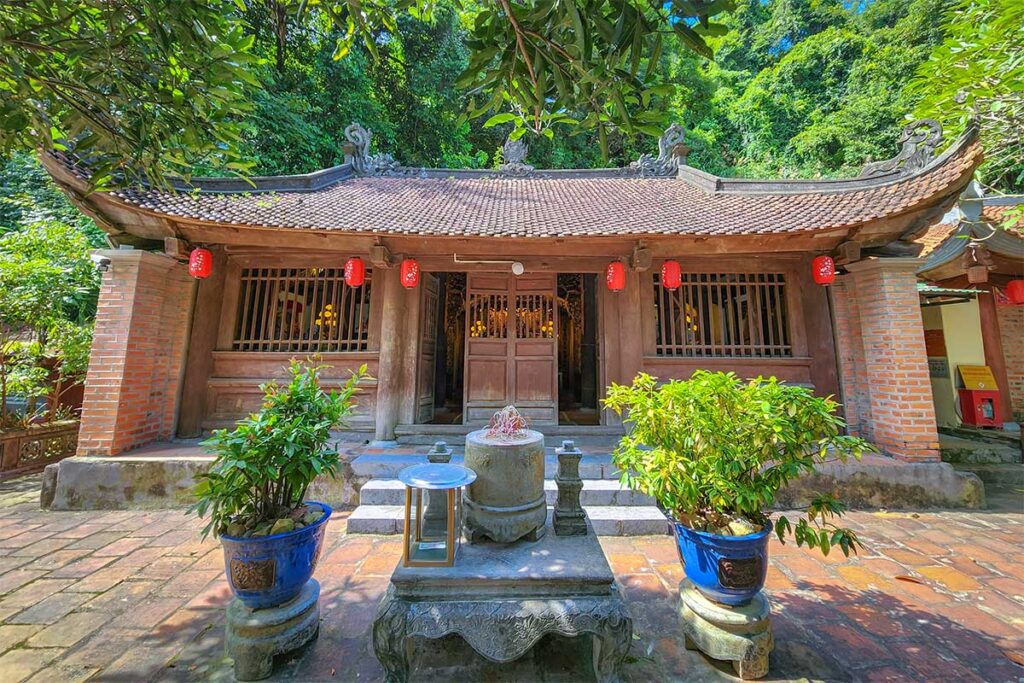
Built near a small stream and shaded by forest, Giai Oan Pagoda commemorates the concubines of King Tran Nhan Tong who are said to have followed him to the mountain and drowned in sorrow when he chose a monastic life.
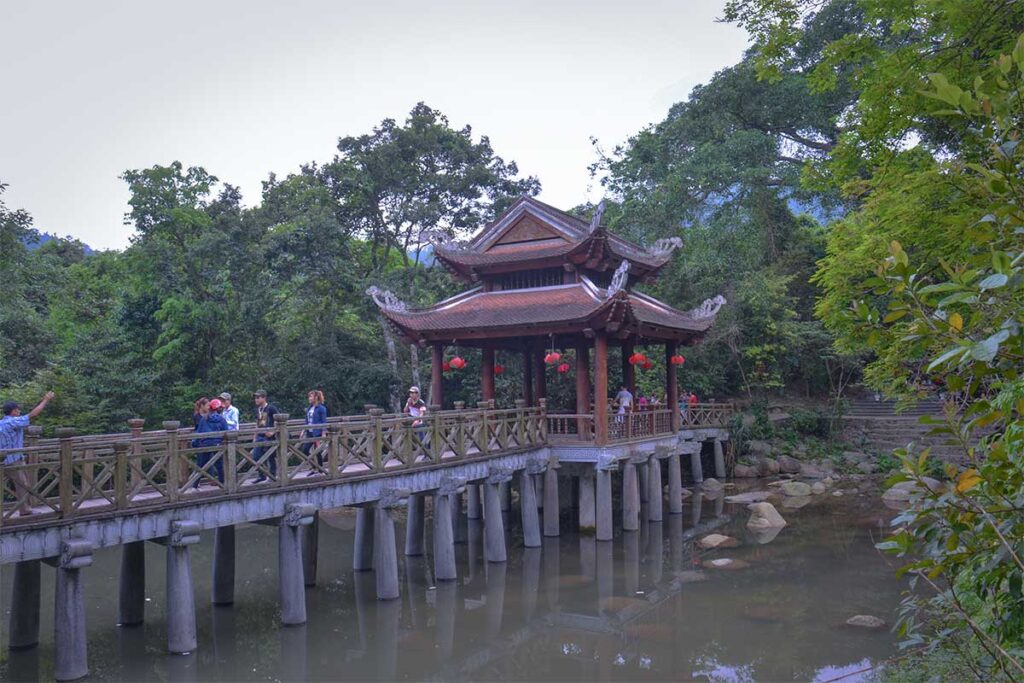
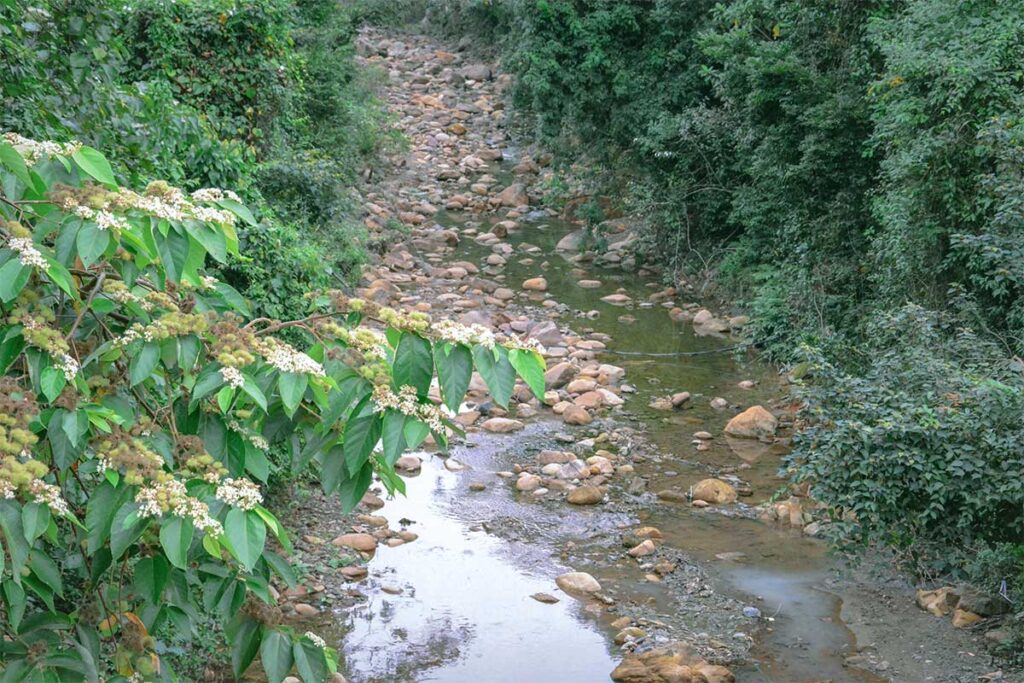
Today, the tranquil setting and gentle stream offer a peaceful place to rest and reflect, regardless of whether visitors know the legend. It’s one of the more atmospheric stops on the lower part of the mountain.
4. Mot Mai Pagoda
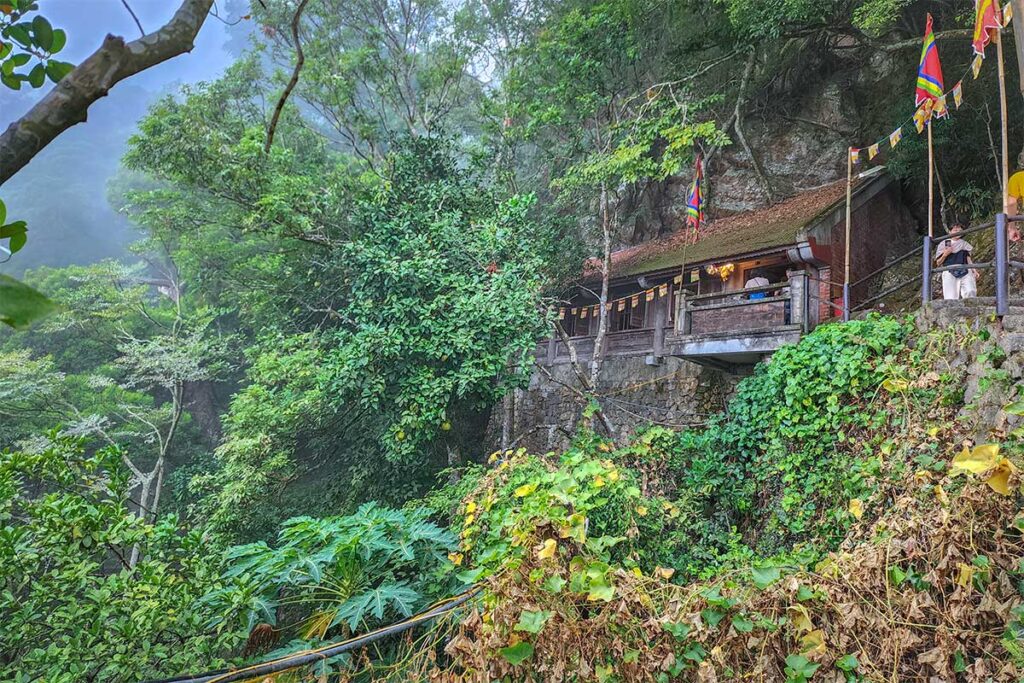
Mot Mai, or “One Roof” Pagoda, is partly built into a cave, with only the front portion visible from the outside. It’s one of the most unique architectural sites on the mountain, blending natural rock with traditional wooden structures. Though small in size, it leaves a lasting impression for its secluded location and quiet setting.
5. Van Tieu & Bao Sai Pagodas
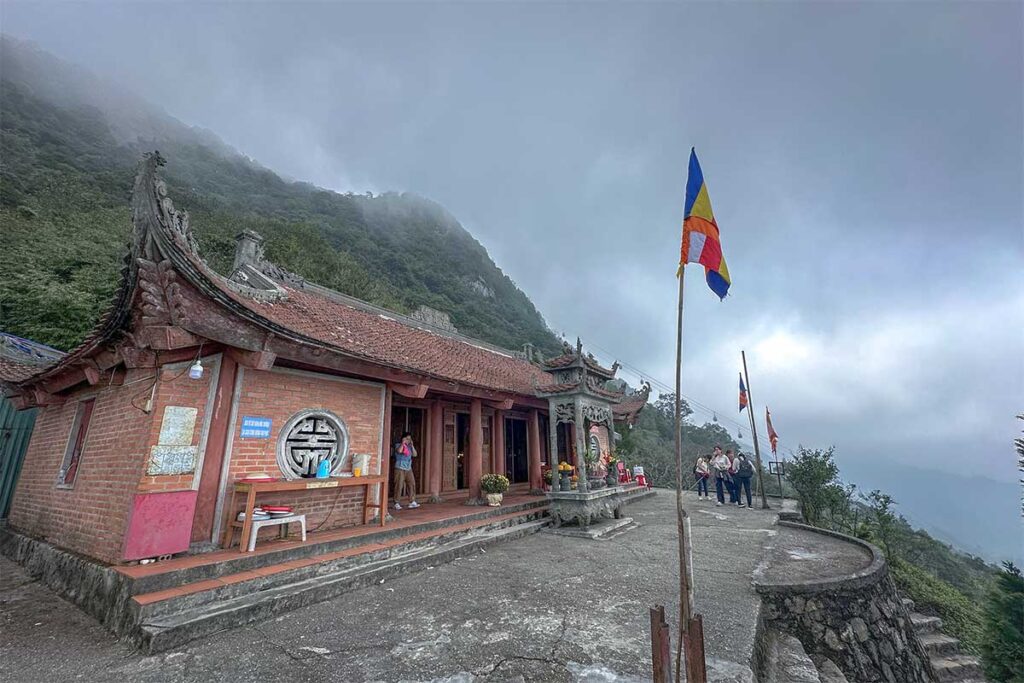
Van Tieu and Bao Sai are two smaller pagodas located at higher elevations, typically reached by those continuing the climb beyond Hoa Yen. Van Tieu is linked to the final teachings of King Tran Nhan Tong, while Bao Sai was originally a cave hermitage. Both were restored in recent decades and retain a more remote, less-visited feel compared to other spots.
6. Hue Quang Stupa
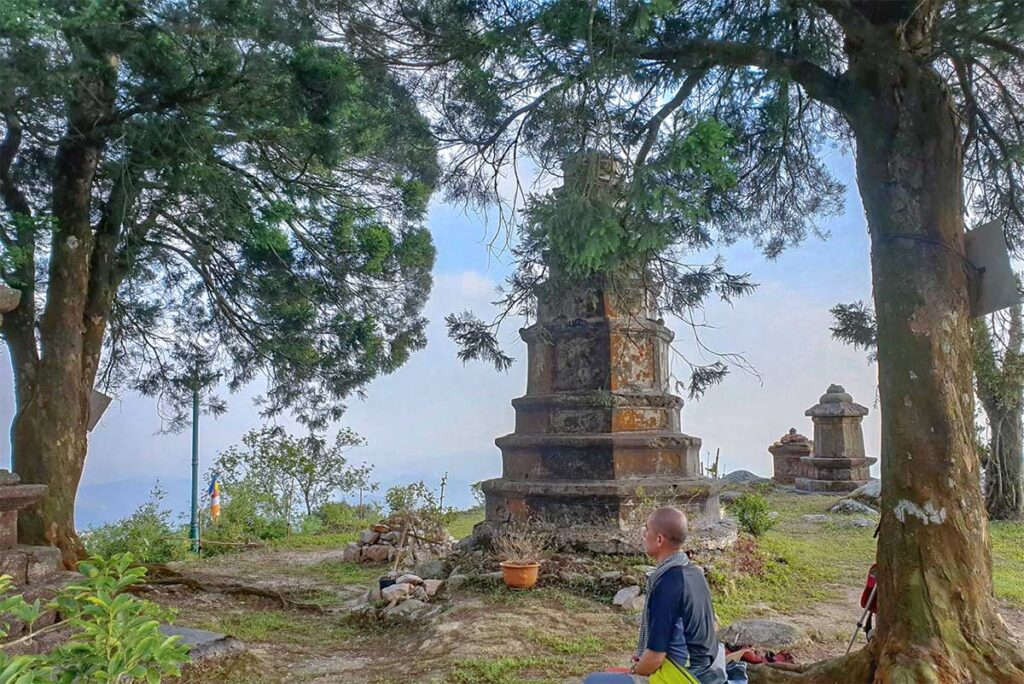
This golden-brick stupa was built to honor King Tran Nhan Tong after his death in 1308 and remains a central monument in the complex. The structure is surrounded by nearly 100 smaller stupas containing the remains of monks from the Truc Lam Zen sect. The intricate base and lotus-shaped top make it a standout both historically and artistically.
Tay Yen Tu (Bac Giang Side)
1. Ha Pagoda, Trung Pagoda, and Thuong Pagoda
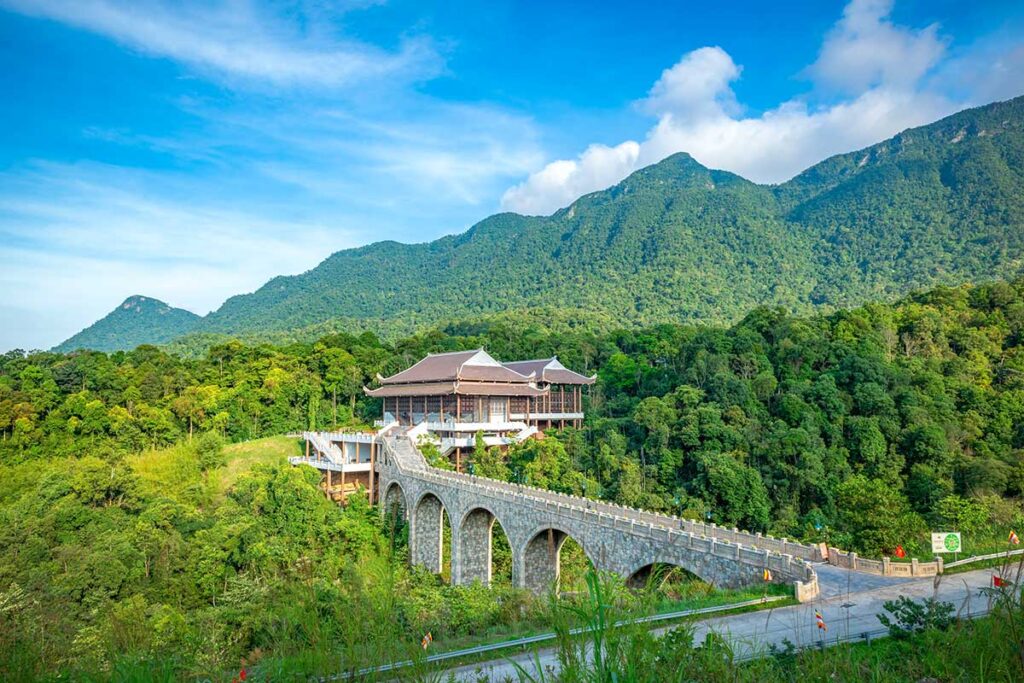
These three pagodas form the core spiritual route on the Bac Giang side, ascending from the valley floor to the upper slopes.
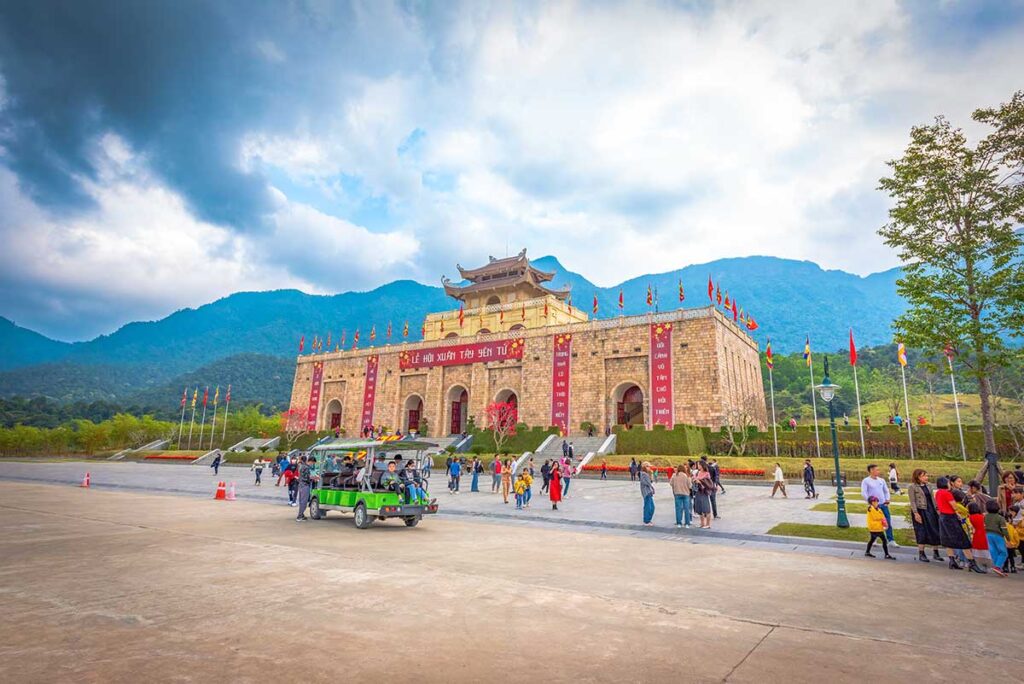
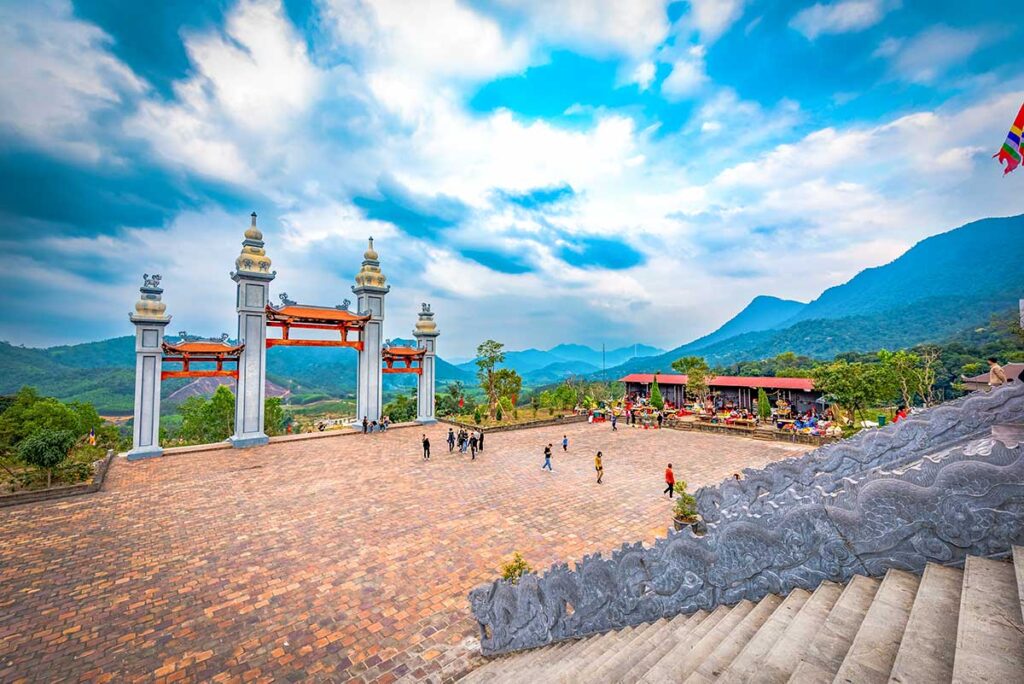
Ha Pagoda sits at the base and is easily accessible, while Trung and Thuong require either a cable car ride or a steep uphill trek. The temples are newer than those on the Quang Ninh side but follow traditional design and are well maintained, with peaceful courtyards and panoramic surroundings.
2. Lake, Square & Scenic Viewpoint
Near the entrance to Tay Yen Tu, a landscaped lake, central square, and paved walking paths make this side more developed and accessible. There’s a scenic viewpoint that looks out over the surrounding forests and low hills, and it’s a popular spot for photos and short walks.
3. Spiritual-Ecological Tourist Area
Still under development, this zone includes modern visitor facilities, walking trails, and areas planned for future retreats and events. A couple of restaurants are already in operation, and while accommodations are not yet available on site, the infrastructure is steadily improving. This side is generally less crowded and offers a more relaxed experience.
Shared Summit Area
1. Panoramic Viewpoint
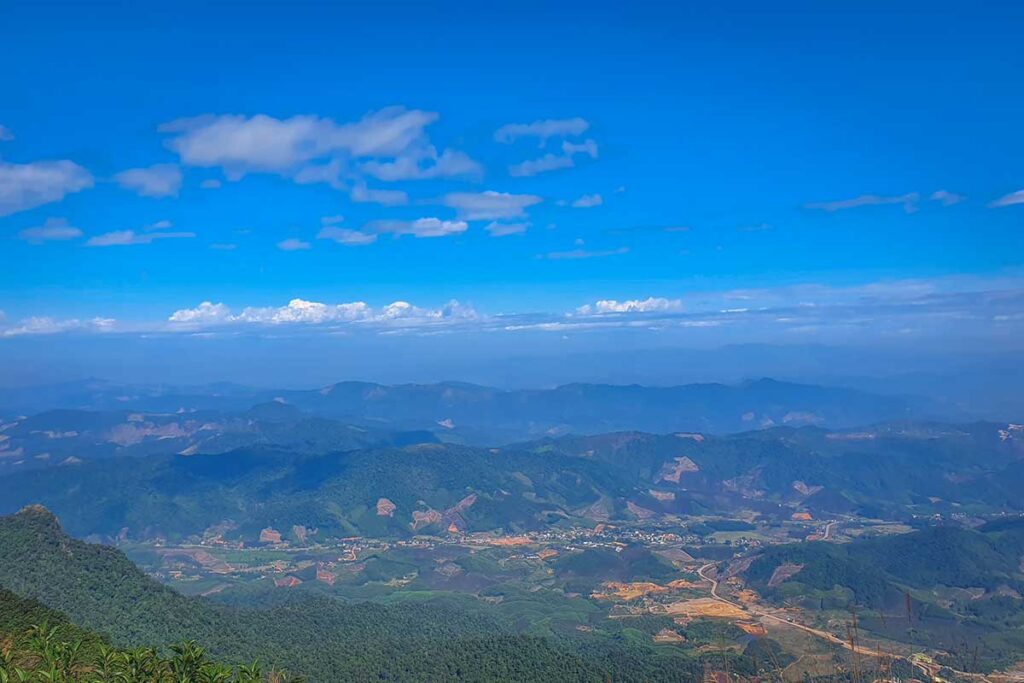
At the summit near Dong Pagoda, visitors from both provinces converge at a rocky viewpoint overlooking the surrounding mountains. On clear days, you can see far into Bac Giang and Quang Ninh, and sometimes even the coast. Clouds often roll in, creating a dramatic scene of mist and shifting light.
2. Path Between Tay Yen Tu and Dong Pagoda
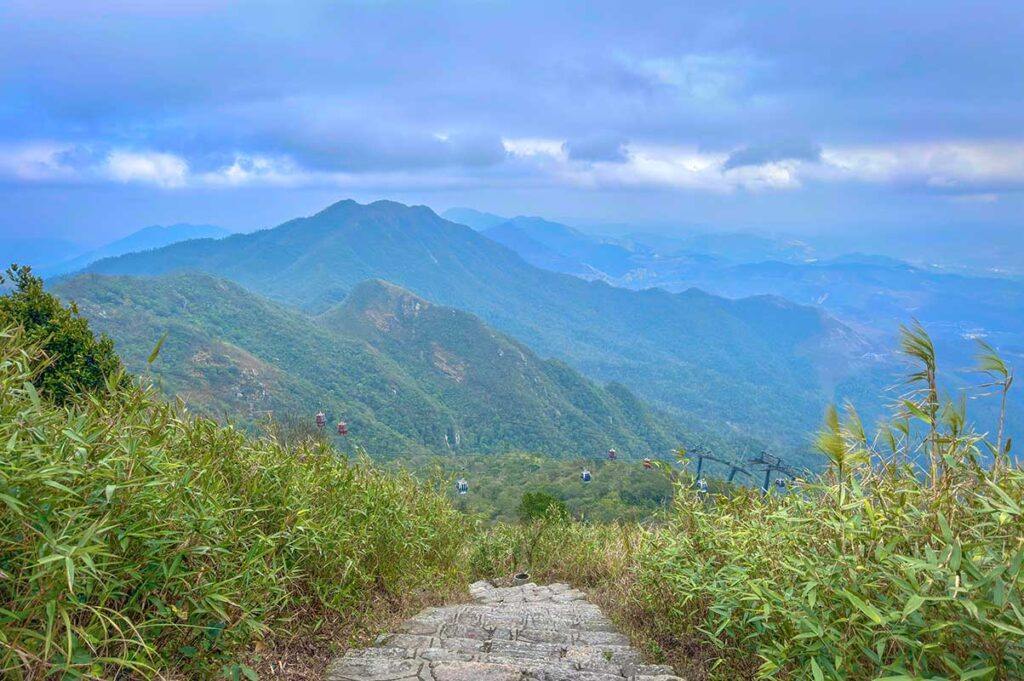
From the upper cable car station on the Tay Yen Tu side, a stone trail leads across the mountain ridge to the Dong Pagoda. The walk takes about 30–40 minutes and includes some steep steps but rewards visitors with increasingly expansive views. This short connection allows travelers to experience both sides of the mountain in a single visit.
Let me know if you’d like a small map illustration or sidebar block summarizing which pagodas are on which side—might help visually separate Quang Ninh and Bac Giang access points for travelers.
Things to do in Yen Tu
Yen Tu offers a mix of nature, culture, and history — all set against the backdrop of a misty mountain range. Whether you’re up for a scenic hike, curious about Vietnam’s Buddhist heritage, or just want to enjoy some mountain air, here are the top things to do:
1. Hike to the summit (or Take the Cable Car)
Climbing to the top of Yen Tu Mountain is one of the most rewarding experiences in the region. The full walking route is about 6 kilometers long and includes over 6,000 stone steps winding through forest, pagodas, and mountain viewpoints.
If you don’t want to hike the entire way, the cable car offers an easier option — or you can do a combination of both to enjoy the views without overexerting yourself.
2. Ride the cable cars for scenic views

There are two different cable car routes on the Quang Ninh side and one on the Bac Giang side (Tay Yen Tu). Each ride takes you high above the pine forest, with panoramic views across the valleys. Even if you enjoy hiking, the cable car is worth doing at least once for the scenery alone.
3. Explore pagodas and historic sites along the way
The pagodas are spread along the trail from the base to the summit, and each offers something different — from ancient ruins and cave temples to bronze structures at the peak. They reflect centuries of history and are surrounded by quiet forest paths, statues, and viewpoints that make the journey feel immersive.
4. Enjoy nature and Take in the Landscape
Even if you’re not into temples, the natural scenery alone makes Yen Tu worth visiting. Tall pine trees, cool mist, moss-covered rocks, and dramatic ridgelines give the area a special atmosphere — especially in spring when wildflowers start blooming. There are plenty of photo spots along the trail and at the summit.
5. Extend your trip with nearby nature spots (Bac Giang Side)
If you enter from the Tay Yen Tu side or stay in Bac Giang, you can combine your visit with nearby attractions like Khe Ro Forest, Mo Stream, or Dong Cao Plateau — all great spots for light hiking, picnicking, or escaping the heat. These places are not part of the Yen Tu complex but offer a nice nature-focused extension.
Yen Tu Festival – What to expect
If you’re interested in Vietnamese culture, the Yen Tu Festival is one of the largest and most traditional events in northern Vietnam. It begins on the 9th day of the first lunar month (usually February) and lasts for about three months. During this time, the mountain gets especially busy with local pilgrims and tourists alike.
The festival includes rituals, traditional music, ceremonial offerings, and cultural performances held at various temples along the trail. While it’s a unique way to experience the spiritual side of Yen Tu, expect large crowds, long queues for the cable car, and less tranquility on the paths.
Tip: If you enjoy lively festivals and don’t mind the bustle, this can be a fascinating time to visit. If you prefer a more peaceful atmosphere or want to hike in quiet surroundings, consider going outside the festival season.
Visiting information & Practical tips
Before heading to Yen Tu, here’s what you need to know about entrance fees, transportation options, cable cars, and how to prepare for the hike. These tips apply to both the Quang Ninh and Tay Yen Tu (Bac Giang) sides.
Entrance Fees
There is no general entrance fee to walk into the Yen Tu area, but you will pay for specific services:
- Cable Car (Quang Ninh side):
- Route 1 (Giai Oan Pagoda to Hoa Yen): 200,000 VND one-way / 280,000 VND round-trip
- Route 2 (Mot Mai Pagoda to Dong Pagoda): 200,000 VND one-way / 280,000 VND round-trip
- Both routes combined: 350,000 VND round-trip
- Cable Car (Tay Yen Tu / Bac Giang side):
- 260,000 VND round-trip / 150,000 VND one-way
- Children under 1.2m and some special categories (veterans, elderly with ID) may receive free or discounted tickets
Opening Hours
- Temples and cable cars typically operate from around 7:00 AM to 5:00 PM
- In festival season, services may run longer but are also more crowded
Cable Car Options
- Quang Ninh side: Two separate cable car lines cover most of the climb and offer great views
- Tay Yen Tu side: A single cable car takes you close to the top, followed by a 30–40 minute walk to Dong Pagoda
- You can hike one way and take the cable car the other if you want a mixed experience
EV Shuttle Service
- Electric vehicles (EVs) operate from parking areas to the base stations on both sides
- Useful for travelers with mobility issues or those visiting with young children
- Expect to pay a small extra fee (usually under 50,000 VND round-trip)
What to Bring
- Good walking shoes or hiking sandals – the paths are long and uneven
- Layered clothing – mornings can be chilly at higher altitudes, especially from December to February
- Snacks and water – food options are limited once you’re on the trail
- Cash – for cable cars, local food stalls, and souvenirs (cards are not widely accepted)
- A bamboo cane (sold near the entrance for ~5,000 VND) – handy for support on steep or slippery sections
Useful Travel Tips
- Avoid weekends and festival season (January–March lunar calendar) for a quieter experience
- Don’t buy herbs or miracle medicines from trailside vendors – they’re unregulated and often overpriced
- Start early if you plan to do the full hike – the full route takes several hours
- Take breaks if hiking all the way – there are plenty of shaded resting spots
- Photography is welcome, but be respectful in active worship areas
Is Yen Tu worth visiting?
Let’s be honest: Yen Tu is not a first pick for most international travelers coming to Vietnam. It’s not as well-known as Ninh Binh, not as easy to reach as major sights in Hanoi, and not as visually striking at first glance as places like Halong Bay or Sapa. Most visitors here are Vietnamese tourists, pilgrims, or those with a deeper interest in Buddhism.
That said, Yen Tu does offer something different:
- If you’re looking for a less touristy cultural site with mountain views and history, it can be a meaningful detour.
- It’s a solid alternative to Perfume Pagoda — also spiritual, but larger in scale, and now with better infrastructure on both the Quang Ninh and Bac Giang sides.
- The cable car ride, ancient pagodas, and peaceful mountain setting can make for an interesting day — if you know what to expect.
It’s not ideal if you:
- Have limited time in the north (you’d likely get more out of Ninh Binh, Hanoi, or Ha Long)
- Want lots of variety in one place (there’s no town, no lake, no nightlife — just temples and nature)
- Are expecting a polished tourist attraction (some parts are still under development, food options are minimal, and signage isn’t always clear)
Bottom line:
Yen Tu is not for everyone — but if you’ve already seen the big sights, want to explore Vietnam’s spiritual heritage, or enjoy long walks in the mountains with a cultural twist, it’s a quiet and rewarding experience. Just don’t expect a bucket-list destination, and you won’t be disappointed.
